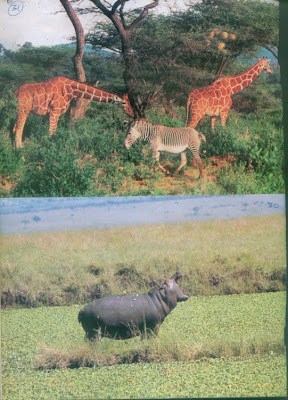Kenya Park Lodges -Top 9 Lodges and Camps Tsavo West National Park

East Africa Kenya National park lodge, camps, cottages and bandas information. Tsavo West Kenya National park accommodation includes Budget, midrange and top end facilities. This short in kenya lodge and camp guide tells you of the services in most of this park’s accommodation. Whether on a budget or luxury park accommodation in Kenya, you need this info.
Budget and midrange park in Kenya accommodations
Apart from camping in the Kenya park itself, the only vaguely budget options are the basic board and lodgings in the roadside town of Mtito andei Gate, but most are pretty seedy and often serve as brothels for long-haul truck drivers.
Your Tsavo Safari Park Hotel in Kenya
1. Ngulia Safari Lodge
Formerly Ngulia Bandas, new management and a complete renovation have turned this hillside camp into Tsavos best luxury bargain. Unusually, it’s self-catering accommodation that really shines, offering thatched tent-fronted stone cottages on the edge of the escarpment overlooking a stream where leopards are known to hide out.
There are rooms without kitchen and bar-restaurant for the won’t-cooks (dinner750) and some more building in progress. All in all the setting and standards outdo plenty of more ambitious lodges at a fraction of the price, with lots of wildlife (inside and out).
2. Kitani Bandas
Run by the same people as the top end luxury Severin Safari Camp. Accommodation here is obviously much simpler than the flash, tented kind but its great value and there’s a small shop providing supplies at not-too-inflated prices. Bandas No.2 and 3 hog the nicest spots, with possibly the cheapest ‘Kili’ views in the park. Its about 2km past its sister site, near a waterhole.
3. Africa Park- Kenya Public campsites
The public sites are at Komboyo, near the Mtito andei gate, and at Chyulu, just opposite the Chyulu gate.
4. Special Campsites
The locations of these bush sites change from time to time so check with the warden. Down in Lake Jipe are some simple bandas.
Top End Hotels, Lodges and Camps in the Tsavo Safari Park Kenya
All prices listed are for full board accommodation.
5. Severin Safari Camp
At Kitani, this is a fantastic complex of thatched luxury tents with affable staff, Kilimanjaro views from the communal lounge area and nightly hippo visitations. Room facilities are excellent (you even get a bidet), and the only reason it’s not classed as a four or five star establishment is the lack of a pool, which seems unduly harsh. The camp also has a self-catering annex, kitani bandas.
6. Kilaguni Serena Lodge
Kilaguni has recently been renovated and is as attractive a place as ever, with a splendid bar and restaurant overlooking a busy illuminated waterhole-the vista stretches all the way from Mt Kilimanjaro to the Chyulu Hills, and guided walks in the nearby Seven Sisters Hills are possible. The extravagant suites are practically cottages in their own right, boasting chintzy living room, minibar, TV’s and large balconies.
7. Finch Hatton’s Safari Camp
An up market tented camp with bone china and gold shower taps, named after Deny’s Finch Hatton, the play boy hunter and lover of Karen Blixen, who died at Tsavo-Kenya Game Parks. It’s situated among springs and hippo pools in the wet of the park, in grounds so sprawling you have to take an escort at night to keep you safe from the animals.
In keeping with the colonial mood, guests are requested to dress for dinner. The camp has its own airstrip (flights from Nairobi cost US$300)
8. Voyager Ziwani
By the Ziwani gate at the southwest end of the park is another luxury tented place, overlooking the Ziwa dam. As well as wildlife walks, you can visit WWWII battle fields and Grogan castle, a fortress like hilltop residence built in the 19th century by swashbuckling British adventurer Ewart Grogan, who became famous for walking from cape town to Cairo to prove his love for a woman!
9. Ngulia Safari Lodge
A curiously unattractive block in a spectacular location, constructed in bad old days of emerging mass tourism hen hotels made little effort to blend in. The surrounding Ngulia Hills attract loads of birds and the lodge puts out bait for leopards, which guarantees you a sighting, if not exactly a place in ecoawareness heaven.
There’s a waterhole right by the restaurant and sweeping views over the Ngulia Rhino Sanctuary on the other side.
Robert is a travel expert with Landmarksafaris.com. An Kenya East Africa Tour and Travel Company Degreed in Kenya Tourism management, he has authored more than 1000 articles on Kenya East Africa travel. See the most luxurious African Kenya Safari Park lodges and camps here:
http://www.landmarksafaris.com/tours/wildlife.php
Labels: African Kenya Game and Safari Parks-Top Kenya Parks Lodges







